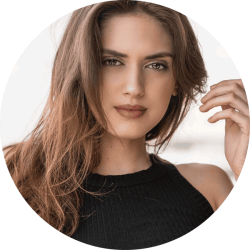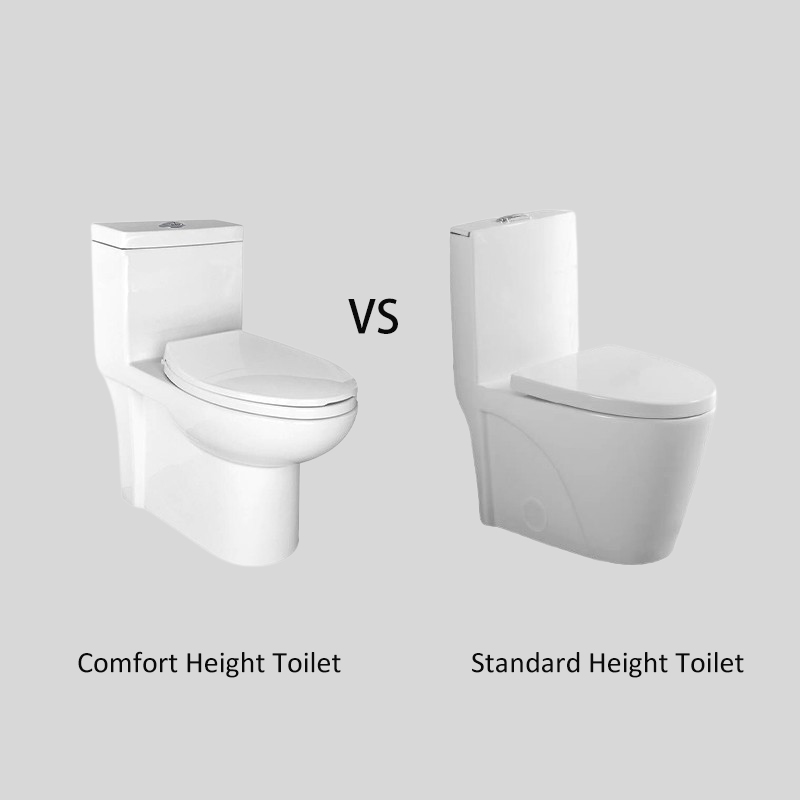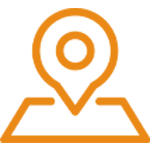 English
English
Jabra Sanitary is a sanitaryware supplier offering toilets, sinks, faucets, bathtubs, etc., at competitive prices. If you're a distributor, wholesaler, or project contractor, get a quote today!
 $23.9 Limited-time Offer
$23.9 Limited-time Offer Consignment Policy
Consignment Policy 20 Years of Experience
20 Years of Experience
When setting up a bathroom, the choice of toilet type is a significant consideration. The two primary contenders are one-piece and two-piece toilets. Both options come with their own set of benefits and drawbacks.
Which is better for your needs: a one-piece or two-piece toilet? This comprehensive guide aims to shed light on key differences between one and two-piece toilets, to assist you in making an informed decision.

Table of Contents
What is a One Piece Toilet
What is a Two Piece Toilet
One Piece vs Two Piece Toilets: Construction and Design
1 Piece vs 2 Piece Toilet: Space Saving
One Piece Versus Two Piece Toilet: Installation Considerations
One vs Two Piece Toilets: Durability and Maintenance
One Piece vs 2 Piece Toilets: Cost Implications
Key Difference Between 1 Piece and 2 Piece Toilets
One or Two Piece Toilet: Which One Should I Install
One-Piece Toilet Maintenance Tips
Two-Piece Toilet Maintenance Tips
How Can We Assist You With Your Toilet Needs?
FAQs
Final Thoughts: One Piece or Two Piece Toilet
A one-piece toilet is a type of toilet where the tank and bowl are manufactured as a single piece, eliminating the seam between the tank and bowl that is typical in two-piece toilets.
This design gives the toilet a sleek, compact appearance and can contribute to a more contemporary look in your bathroom.
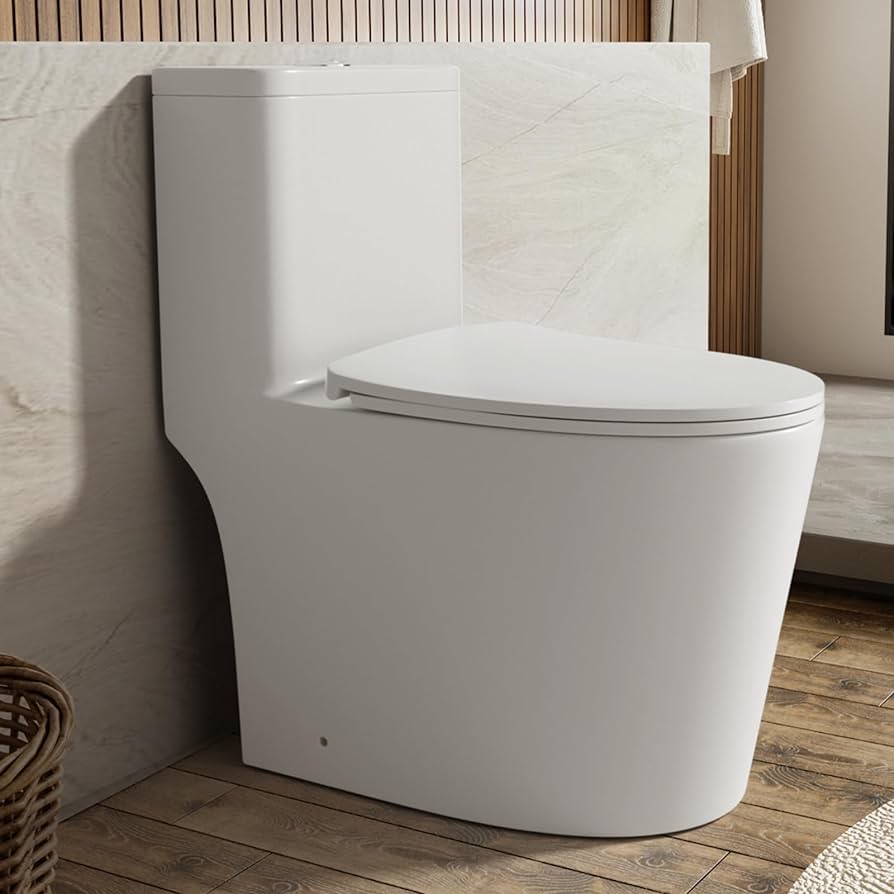
One-piece toilets offer a modern and streamlined option for bathroom design, characterized by the tank and bowl being integrated into a single unit. Check pros and cons of one piece toilet below:
Pros of One-Piece Toilets
- Aesthetic Appeal: Their seamless design is visually appealing and can add a touch of elegance to any bathroom.
- Ease of Cleaning: With fewer crevices and seams, one-piece toilets are easier to clean compared to their two-piece counterparts.
- Durability: The integrated design can be more durable with less risk of leaks between the tank and the bowl.
- Installation: They are generally easier to install since there's no need to attach the tank to the bowl.
- Space-Saving: Often more compact, they are a good choice for small bathrooms.
Cons of One-Piece Toilets
- Cost: They tend to be more expensive than two-piece toilets due to the complexity of their design and manufacturing process.
- Weight: One-piece toilets are heavier, which might make handling and installation challenging without assistance.
- Repair and Replacement: If a part of a one-piece toilet breaks, you may have to replace the entire toilet, whereas with a two-piece, you might only need to replace the damaged section.
Pros |
Cons |
|---|---|
Sleek design. Comfort height available (17–19 inches) |
It's a bit heavy |
Easy-to-clean |
Comes with a higher price tag |
Built to last |
Hard to install or maintenance |
A two-piece toilet consists of a separate bowl and tank. This is the most traditional toilet design, with the tank and bowl manufactured as individual pieces and assembled during installation.
The design flexibility and accessibility of components make two-piece toilets a popular choice in many households.
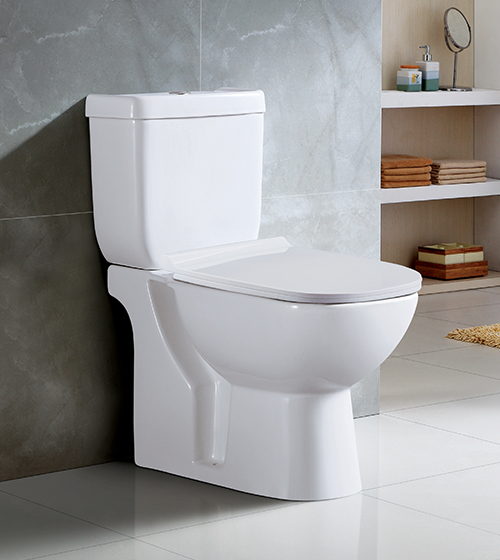
Two-piece toilets are a common choice for residential and commercial bathrooms, distinguished by their design where the tank and bowl are separate units bolted together during installation.
Pros of Two-Piece Toilets
- Cost-Effective: Generally, two-piece toilets are less expensive than one-piece models, making them more accessible for budget-conscious buyers.
- Ease of Handling and Installation: Because they are not one solid unit, the separate pieces can be easier to maneuver and install, especially in tight spaces or where weight is a concern.
- Repair and Maintenance: Repairs tend to be simpler with two-piece toilets since you can replace just the tank or bowl if needed, rather than the entire fixture.
- Availability of Parts: Replacement parts for two-piece toilets are readily available and often universal, which can make maintenance over time more manageable and cost-effective.
Cons of Two-Piece Toilets
- Cleaning Difficulty: The seam between the tank and bowl can collect grime and bacteria, making them harder to clean than their one-piece counterparts.
- Leak Potential: The gasket that seals the tank to the bowl can wear out over time, potentially leading to leaks that require attention.
- Bulkier Appearance: They generally have a more prominent and less streamlined appearance compared to one-piece toilets, which might not suit all bathroom aesthetics.
Pros |
Cons |
|---|---|
Cost savings |
A less modern look |
Ease of repair |
Cleaning challenges |
Flexibility during installation |
Tends to leak |
One Piece vs Two Piece Toilets: Construction and Design
One-Piece Toilets: These toilets integrate the tank and the bowl into a single, seamless unit. This design minimizes crevices where dirt and bacteria can accumulate, making them easier to clean.
Two-Piece Toilets: In these models, the tank and bowl are separate pieces that are bolted together. They have a more traditional appearance. However, they might have more potential spots for dirt to hide.
1 Piece vs 2 Piece Toilet: Space Saving
One-Piece Toilets: They feature a modern look and can be a great space-saver, making them ideal for smaller bathrooms.
Two-Piece Toilets: Their design flexibility can be a benefit in various bathroom layouts.
One-Piece vs. Two-Piece Toilets: Installation Considerations
One-piece toilets: They are generally heavier because they are a single unit. This can make installation more challenging.
However, once a one-piece toilet is positioned correctly, the rest of the installation is straightforward.
Two-piece toilets: They are usually lighter to move in pieces, making them easier to position and install, especially in tight spaces.
But you need additional steps to assemble the tank and bowl.
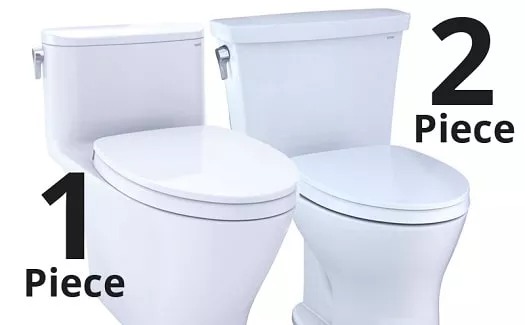
One vs Two Piece Toilets: Durability and Maintenance
One-piece toilets: They often have fewer issues with leaks between the tank and bowl since there are no joints. One-piece toilets score high on durability due to their seamless design.
Two-piece toilets: They require occasional checks for leaks at the joint between the tank and bowl. These can usually be fixed easily by replacing the gaskets or bolts.
However, they are often less costly both in initial purchase and for potential repairs, as you can replace individual parts rather than the entire toilet.
One Piece vs 2 Piece Toilets: Cost Implications
One-piece toilets: They tend to be more expensive upfront due to their sophisticated design and manufacturing process. However, one-piece toilets, while generally pricier, offer a modern, space-saving design and ease of maintenance.
Two-piece toilets: Typically, they are more budget-friendly. They have been on the market longer and are easier to produce.
Key Difference Between 1 Piece and 2 Piece Toilets
At first glance, the difference between one and two-piece toilets seems straightforward.
A one-piece toilet features a streamlined design and is simpler to clean due to its lack of crevices, making it a hygienic option.
On the other hand, the two-piece toilet's separate components make it easier to maneuver during installation.
However, you might find that setting up a one-piece toilet can be quicker overall, despite its heavier weight.
When it comes to cost, one-piece toilets are generally more expensive. While two-piece toilets are generally affordable and easier to transport due to their separate components.
They may require more attention over time as the joint between the two sections can lead to leaks, especially if any part gets damaged.
Both styles provide a wide range of customization options to suit different preferences and needs.
Despite the design differences, the performance of one-piece and two-piece toilets is generally similar. Both types can offer efficient flushing mechanisms and water-saving features.
One or Two Piece Toilet: Which One Should I Install
When choosing between a one-piece and a two-piece toilet, several factors come into play. Here's some advice on how to choose the right one for your bathroom:
- Consider the Bathroom Size: One-piece toilets are more compact and fit well in smaller bathrooms. Two-piece toilets can be more adaptable to different spaces.
- Budget: If cost is a concern, a two-piece toilet generally offers a less expensive option, both for initial purchase and for future repairs.
- Aesthetic Preference: Consider which style complements your bathroom's overall design. One-piece toilets are sleeker, while two-piece toilets have a more classic look.
- Cleaning and Maintenance: If ease of cleaning is important, a one-piece toilet's smooth, joint-free design might be more appealing.
- Installation: If you plan to install the toilet yourself, a two-piece model might be easier to manage because of its separate components.
By analyzing these factors and considering your specific needs and preferences, you can make a well-informed decision on whether a one-piece or two-piece toilet is better suited for your bathroom.
One-Piece Toilet Maintenance Tips
Maintaining a one-piece toilet is crucial for ensuring its longevity and optimal performance. Here are some practical tips to help you take care of your one-piece toilet effectively:
Regular Cleaning
- Daily and Weekly Cleaning: Use a gentle, non-abrasive cleaner to wipe down the exterior and interior of the toilet regularly. This prevents the buildup of stains and bacteria. For daily maintenance, a quick wipe with a disinfectant can keep the surface clean.
- Deep Cleaning: Once a week, apply a toilet bowl cleaner under the rim and let it sit for several minutes before scrubbing with a toilet brush. This helps remove tough stains and mineral deposits.
Check for Leaks
- Regular Inspections: Periodically check around the base of the toilet and the connection to the water supply for any signs of leaks. Early detection can prevent water damage and costly repairs.
- Seals and Connections: Ensure that all seals are intact and the connections are secure. Replacing the wax seal under the toilet every few years can prevent leakage at the base.
Handle Clogs Carefully
- Use a Plunger: For minor clogs, a plunger can often do the job. Ensure you're using a toilet plunger with a flange, as it provides extra suction and seal.
- Avoid Chemical Cleaners: Harsh chemical drain cleaners can damage the internal components of your toilet. If plunging doesn't resolve the clog, consider using a plumber's snake or call a professional.
Minimize Wear and Tear
- Avoid Harsh Chemicals: Strong chemicals can corrode the flushing mechanism and degrade the toilet's surface. Use mild cleaners specifically designed for toilet bowls.
- Soft-Close Seat: If your model does not come with a soft-close toilet seat, consider installing one to prevent the seat from slamming. This not only reduces noise but also minimizes the risk of damage to the toilet.
Regular Component Checks
- Inspect Internal Mechanisms: Lift the lid of the tank periodically to inspect the flush mechanism. Make sure the fill valve and flapper are functioning correctly and replace them if they show signs of wear or leakage.
- Adjustments: Adjust the float and the chain connecting the flapper if necessary to ensure efficient flushing and water conservation.
Preventive Maintenance
- Professional Inspection: Having a professional plumber inspect your toilet every few years can help catch issues that might not be visible to the untrained eye, such as slow leaks or deterioration in the piping.
Following these maintenance tips can help ensure that your one-piece toilet remains clean, efficient, and functional for many years, contributing to the overall hygiene and appeal of your bathroom.

Two-Piece Toilet Maintenance Tips
Regular Cleaning
- Daily Wiping: Use a mild cleaner and a soft cloth to wipe down the outside of the toilet daily. This prevents the buildup of germs and grime.
- Weekly Scrubbing: For the bowl, use a non-abrasive toilet cleaner. Apply it under the rim and let it sit for a few minutes before scrubbing with a toilet brush. This helps maintain a clean and stain-free bowl.
Check for Leaks
- Tank and Bowl Connection: Since two-piece toilets have a separate tank and bowl, it's important to check the joining bolts for any signs of leakage regularly. Tighten them if they feel loose, but be careful not to overtighten, as this can crack the porcelain.
- Water Supply Line: Periodically inspect the line and the valve for any drips or wetness, and replace them if they appear worn or damaged.
Handle Clogs Carefully
- Use a Plunger: A good plunger is your first defense against toilet clogs. Make sure to use a plunger designed for toilets to effectively clear blockages.
- Avoid Chemicals: Chemical drain cleaners can damage your plumbing over time. If a plunger doesn't work, try using a plumber's snake to remove the clog mechanically.
Minimize Wear and Tear
- Avoid Harsh Chemicals: Strong cleaning agents can damage the toilet's finish and internal components. Use gentle, non-abrasive cleaners to keep the toilet clean.
- Protect Components: Be cautious about what you flush. Avoid flushing anything other than toilet paper and human waste, as other items can cause blockages and damage the flushing mechanism.
Regular Component Checks
- Inspect Flapper and Fill Valve: Open the tank lid occasionally to check these parts for wear or degradation. Replace them if they do not seal properly or if they allow water to run continuously.
- Adjust Float: Make sure the float is properly adjusted to prevent the tank from overfilling, which can lead to leaks and wasted water.
Preventive Maintenance
- Seal and Gasket Checks: Regularly check the gasket between the tank and bowl. If you notice it's worn or if there are leaks, replace it to ensure a tight seal and prevent water from leaking onto the floor.
- Professional Inspections: Even if no problems are apparent, it's a good idea to have your toilet checked by a professional plumber every few years to ensure everything is functioning correctly.
By following these maintenance tips, you can extend the life of your two-piece toilet and ensure it operates efficiently, saving you both money and time in the long run. Regular maintenance not only prevents major repairs but also contributes to the overall cleanliness and functionality of your bathroom.

How Can We Assist You With Your Toilet Needs?
If you're deliberating over the choice between one-piece and two-piece toilets and their functionality, Jabra expert team is ready to provide comprehensive support.
As the best toilet manufacturer, we have highly trained professionals on board, we guide you seamlessly through the installation process, ensuring that each step is handled with the utmost care.
Whether you're in search of a toilet that complements your bathroom's style or need assistance adhering to installation guidelines and safety precautions, Jabra Sanitary is committed to meeting your needs.
FAQs
1. Which type of toilet is more eco-friendly, one-piece or two-piece?
Both one-piece and two-piece toilets can be eco-friendly depending on the flushing system they employ. The key factor is not the style of the toilet but rather the type of flush mechanism and the amount of water it uses per flush.
Models with lower gallons per flush (GPF) ratings or dual-flush capabilities tend to be more environmentally friendly.
2. Can I replace a one-piece toilet with a two-piece toilet?
Yes, you can replace a one-piece toilet with a two-piece toilet. The main consideration is the rough-in measurement and space available in your bathroom. Ensure that the new toilet fits the existing plumbing and space constraints.
3. Are there water-saving options for both one-piece and two-piece toilets?
Absolutely. Many modern one-piece and two-piece toilets are designed with water efficiency in mind. Look for toilets with Watermark and WaterSense certification, which indicates compliance with EPA criteria for water efficiency.
Dual-flush toilets, which allow you to choose between a full or reduced flush for liquid or solid waste, are also excellent for water conservation.
4. Are there different flushing systems available for one-piece and two-piece toilets?
Yes, both types of toilets can come equipped with various flushing systems, including gravity-feed, pressure-assisted, dual-flush, and others.
Each type offers different benefits, such as water conservation or powerful waste removal. The choice of flushing system can be independent of whether the toilet is one or two pieces.
5. What's the lifespan of a typical toilet?
A typical toilet can last anywhere from 15 to 30 years, depending on its construction, material quality, and maintenance.
Regular cleaning and timely replacement of components like flappers and fill valves can extend a toilet's lifespan.
6. Are there design variations within one-piece or two-piece toilets?
Yes, two-piece toilets come in various designs, including traditional, contemporary, and transitional styles. They also vary in terms of bowl shapes (such as round or elongated) and heights (standard or comfort height).
This variety allows them to integrate well with different bathroom aesthetics and user preferences.
Final Thoughts: One Piece or Two Piece Toilet
Both one-piece and two-piece toilets have their own merits and shortcomings. Your choice will depend on your budget, space constraints, design preferences, and the importance you place on factors like ease of cleaning and maintenance.
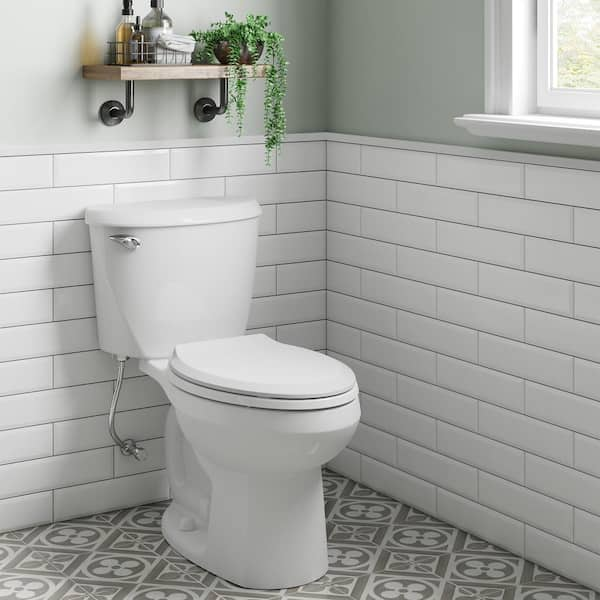
Regardless of your decision, ensure you choose a high-quality toilet, like one from the Jabra toilet brand, that guarantees durability and efficient performance.
Please note that the information provided in this article is meant to serve as a guide and does not replace professional advice. Always consult with a professional before making any significant decisions regarding bathroom fixtures.
References
- wikihow:How to Buy a Toilet: 13 Steps (with Pictures)
- 5 Reasons to Choose a 1-Piece Toilet Over a 2-Piece Toilet
- Comparing the Pros and Cons of a One-Piece and Two-Piece Toilet
Disclaimer: The links provided are for reference purposes and are not intended as endorsements of any products or services. Please conduct your own research before making a purchase.







